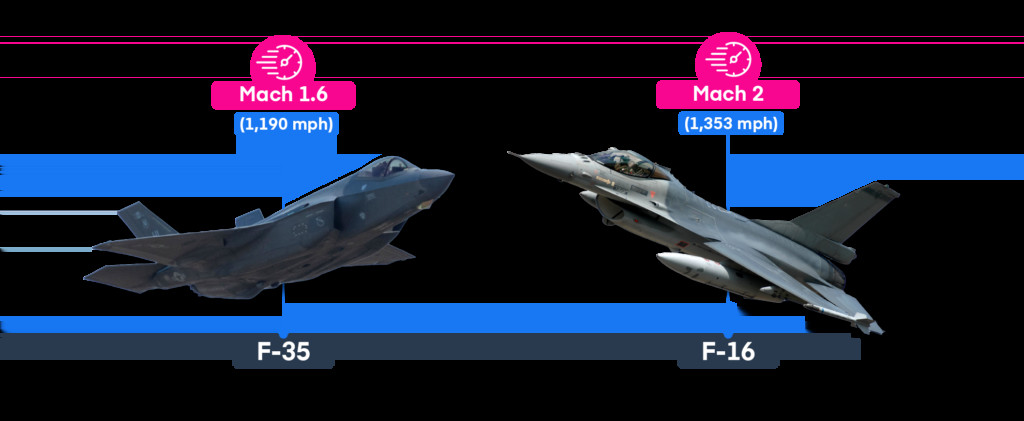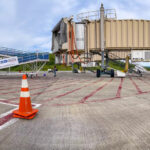Look up into the sky, and you might see a plane gracefully gliding overhead. It may seem to be moving slowly, but that’s an illusion created by distance. In reality, jet planes are incredibly fast, often cruising at speeds approaching the sound barrier.
From our vantage point on the ground, judging the true speed of an aircraft soaring miles above can be deceiving. They appear to drift lazily, while in fact, they are covering ground at a remarkable pace.
This article will explore the speeds of various types of aircraft, measured in miles per hour (mph), and offer a glimpse into the future of aviation speed.
Key Facts About Airplane Speed
- Airplanes measure speed using airspeed, not ground speed, which is affected by wind.
- The Mach number is crucial for understanding speeds near the speed of sound.
- Most passenger planes fly near Mach 1 but stay below it to avoid structural stress and sonic booms, unless specifically designed for supersonic flight.
- Military jets are built for supersonic speeds for tactical advantages.
- General Aviation aircraft operate at lower, slower speeds.
- Supersonic passenger flight may be returning soon, with hypersonic technology on the horizon.
How Fast Do Commercial Airplanes Fly in MPH?
For commercial airlines, speed is a careful calculation balancing flight time and fuel efficiency. Flying faster reduces travel time but dramatically increases fuel consumption. Aircraft manufacturers determine the optimal cruising speed for each model based on its intended routes.
The Airbus A320 and Boeing 737, the most common narrow-body airliners, typically cruise at around Mach 0.78, which translates to approximately 587 mph.
Larger, long-haul airliners like the Boeing 787 and Airbus A380 are designed for extended routes and fly slightly faster to maximize time savings on long journeys. These aircraft generally cruise at Mach 0.85, or about 669 mph. The longer the flight, the more crucial this speed advantage becomes.
 Boeing 787 and Airbus A380 airliners in flight
Boeing 787 and Airbus A380 airliners in flight
Private jets prioritize speed even further. Operators are willing to use more fuel to save valuable time for their passengers. Modern private jets also often fly at higher altitudes than commercial airliners, between 45,000 and 51,000 feet. The thinner air at these altitudes allows aircraft like the Gulfstream GV series and Bombardier Global Express to achieve cruise speeds of Mach 0.90, or roughly 715 mph.
Historically, the Concorde was the fastest commercial airplane ever to operate. Introduced in 1976, this aircraft was specifically engineered for supersonic flight, cruising at Mach 2.04, an astounding 1,559 mph. It could famously cross the Atlantic Ocean in under three hours, a journey that takes conventional airliners at least six hours.
 A Concorde supersonic airliner in flight
A Concorde supersonic airliner in flight
However, the Concorde’s incredible speed came with significant operating costs, which ultimately led to its retirement in 2003.
How Fast Do Military Airplanes Fly in MPH?
Military aircraft speeds are dictated by their specific missions.
Military transport, tanker, and cargo aircraft serve roles similar to commercial jets, and their speeds are therefore comparable.
For instance, cargo planes such as the Boeing C-17 Globemaster and the Lockheed C-5 Galaxy cruise at around Mach 0.77, approximately 520 mph. Notably, these are slightly slower than commercial jets, as their design emphasizes cargo capacity and the ability to operate from shorter runways over sheer speed.
Fighter jets are engineered to be the fastest military aircraft because speed is a critical advantage in aerial combat. Consequently, all modern fighter jets are capable of supersonic flight.
Multi-role fighters like the F-35 and F/A-18E can reach speeds of Mach 1.6, about 1,190 mph. Interceptor aircraft, such as the F-16, prioritize speed over stealth or aircraft carrier compatibility and can fly even faster, up to Mach 2, or 1,353 mph.
 Two military fighter jets, an F-35 and an F-16, in flight side-by-side
Two military fighter jets, an F-35 and an F-16, in flight side-by-side
Interestingly, these fighter jets typically achieve their maximum speeds for short bursts using afterburners. In normal cruising flight, they fly at subsonic speeds, around Mach 0.9, or 621 mph.
Some advanced military jets possess “supercruise” capability, allowing them to sustain supersonic flight for extended periods without using afterburners. Examples include the F-22 Raptor, which supercruises at Mach 1.82 (1,220 mph), and the Eurofighter Typhoon at Mach 1.5 (1,035 mph). When using afterburners, the F-22 can reach an even higher speed of Mach 2.25 (1,500 mph).
The Lockheed SR-71 Blackbird holds the record as the fastest jet aircraft ever built. This long-range, high-altitude reconnaissance aircraft operated during the Cold War. The Blackbird could reach an astonishing Mach 3.32, or 2,193 mph, enabling it to outrun any interceptor aircraft or surface-to-air missiles.
Its unmatched speed and altitude capabilities allowed it to fly reconnaissance missions unchallenged for over 24 years. It was only retired in the 1990s due to the advancements in satellite-based reconnaissance technology.
How Fast Do Small Airplanes Fly in MPH?
At the slower end of the airspeed spectrum are small general aviation aircraft. These planes typically fly at speeds below 300 knots (Mach 0.45) and at altitudes under 25,000 feet. At these lower speeds and altitudes, the Mach scale is less relevant, and pilots primarily use indicated airspeed (IAS).
General Aviation airplanes include popular four-seater models like the Cessna 172, Piper Cherokee, and Diamond DA40. These aircraft typically cruise around 125 knots, or 143 mph, with maximum speeds around 160 knots, or 184 mph. Newer single-engine aircraft such as the Cirrus SR22 and Columbia 350 can reach speeds up to 200 knots, or 230 mph.
 A Diamond DA40 general aviation airplane in flight
A Diamond DA40 general aviation airplane in flight
These smaller airplanes are considerably slower than jet aircraft because they use piston engines, which produce significantly less power than jet engines. Piston engines are also less efficient in the thinner air at higher altitudes.
To improve performance at higher altitudes, particularly above 15,000 feet, manufacturers often equip aircraft with turbochargers. Turbochargers compress the incoming air, increasing engine power in thinner air. Turbocharged versions of general aviation aircraft offer a noticeable increase in top speed and cruise altitude.
For example, the Mooney M20 Bravo Turbo can fly approximately 35 knots, or 41 mph, faster than its non-turbocharged counterpart. It also has a higher cruise altitude of 25,000 feet compared to the standard model’s 18,500 feet.
In general, modern general aviation aircraft haven’t seen dramatic speed increases compared to older models. The focus in this sector has shifted towards enhancing comfort, safety features, and fuel efficiency, rather than prioritizing speed.
What Are Future Airplane Speeds Expected to Be?
Given the challenges associated with approaching Mach 1 for passenger comfort and fuel efficiency, conventional airliners are unlikely to become significantly faster than current models. Achieving substantial reductions in travel time would require entirely new aircraft designs.
However, supersonic passenger flight may be on the verge of a comeback. Several supersonic aircraft are currently under development, with initial flights anticipated as early as 2024. NASA and Lockheed Martin’s X-59 and Boom Technology’s Overture are leading contenders in the race to revive supersonic commercial aviation.
Why did supersonic passenger travel disappear after the Concorde?
The development of supersonic aircraft slowed down after the Concorde’s retirement. High operating costs were a major factor, but another significant issue was the intense sonic boom produced when the aircraft exceeded Mach 1.
A sonic boom is a loud, thunder-like noise created by shockwaves that form when an aircraft flies faster than the speed of sound. This noise caused considerable public opposition in populated areas overflown by the Concorde.
Consequently, aviation authorities like the FAA placed bans on civil supersonic flight over land. These restrictions severely limited the routes Concorde could fly and discouraged further supersonic aircraft development.
NASA’s X-59 QueSST mission aims to mitigate the sonic boom, reducing it to a much quieter “sonic thump.” The X-59’s unique aerodynamic shape is designed to direct sonic booms upwards, away from the ground, while cruising at Mach 1.4, or 937 mph.
With its first flight scheduled for 2024, NASA hopes that this technology will persuade regulators to reconsider the ban on supersonic flight over land.
Boom Technology’s Overture is an 80-passenger airliner designed to fly at Mach 1.7, or 1,100 mph. This aircraft is in active development and is projected to begin flight testing by 2026.
While there have been previous unsuccessful attempts to create a Concorde successor, such as the Aerion AS2 and Boeing Sonic Cruiser, the Boom Overture shows considerable promise, having already secured orders from United Airlines and American Airlines. With a current order book of 130 aircraft, its future appears bright.
Beyond supersonic, there’s the realm of hypersonic flight, involving speeds exceeding five times the speed of sound.
The North American X-15 holds the record for the fastest speed achieved by a crewed, powered aircraft, reaching Mach 6.7, or 4,520 mph, back in 1967. Since then, most hypersonic research has focused on missile and rocket technology.
However, in June 2023, Boeing unveiled a concept for a hypersonic passenger aircraft that could potentially cross the Atlantic in just two hours. This aircraft would utilize a combination of jet and ramjet engines to cruise at a blistering Mach 5. While still a concept, passenger hypersonic flight may become a reality within the next 20 to 30 years.
Conclusion
Still wondering about the different types of speeds we discussed?
Check out our comprehensive guide to the six different types of airspeed here.
